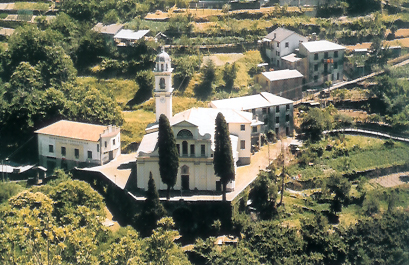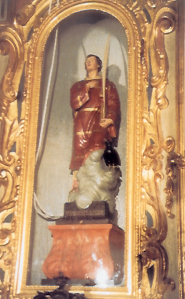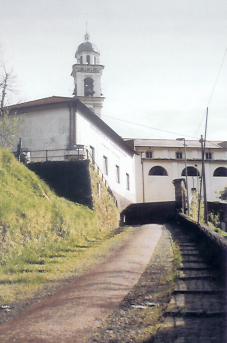| |
Catholic Parish of San Vincenzo
(pgs 251 - 259 “Il mio Paese”
by Padre Celso da Favale)
“It is not known, written by the priests Angelo and Marcello Remondini, the origin of the church, or better, of the primitive chapel of Favale, but form the succession of the Priests, one can infer that the first modest chapel of the village was built at the time of the invention of the relics of S. Vincenzo Martyr (1147), during the second crusade.” The information is documented by the research done by the historian from Rapallo, Arturo Ferretto. He states that the church of S. Vincenzo de Fontebono already existed in the last decade of the 12th century, affiliated, during that time, to the parish of Cicagna, which until 1621 had been the Pieve [Parish Church] meaning the civil and religious center of all the surrounding villages.
 |
| Figure 137 It is a picture, while it seems a delightful painting of Monet. The parish church of San Vincenzo di Favale (1607) with the annexed rectory, the large square watched over by the two upright cypresses, the bell tower (1616), 34 meters high with its five bells, the main bell 18 quintals [3968 lb.], ready to deliver the time marked on the clock-face. On the left the former oratory (1827), starting in 1872 “Parochial Recreation Center Cesare Pezzolo” Further up the first houses of Acereto between the strips outstretched at the sun, embellished by the two bands of road. |
“According to the tradition, writes Antonio Cordano, during the long night of Passion, when the plagues and the wars alternated for almost two centuries (1300-1400), the primitive church of S. Vincenzo di Favale was abandoned and turned into a ruin. The population was decimated, even lacking priests, the church of Favale remained empty for a long time. It was then given in commenda (in title) to the rectory of S. Andrea of Verzi, to which it remained united, as a branch, from 1464 to 1598. At that time the rectory of Verzi was one of the most extended of the so called Lavagnina valley. It even bordered with the Dioceses of Tortona and it was called the original church of the Malvaro.”
(Antonio Cordano continues) “Meanwhile, waiting to regain the parochial independence, the inhabitants of Favale decided to build a small chapel (chiesuola) in the flat space of Priagna, dedicating it, by spontaneous vote of the people, to their protector S. Rocco. Once their autonomy was regained, the people of Favale, realizing the extreme roughness of their chapel, and that it had become insufficient for the people, they thought of building a new one. But where? Among some of them there was the idea of building it again in the hamlet of Priagna.
 |
| Figure 149 – Luigi Agretti. Mythological flight of the sparrows carrying sand from Priagna, to the plateau where San Vincenzo’s chapel was, gives a sign and a commencement of the building of a new church right on that spot. In the background the mountain range of Favale, the sky and the village from where the sparrows come. |
(Antonio Cordano continues) “Others instead preferred the same location where the primitive chapel dedicated to S. Vincenzo existed. According to the legend, the swallows contributed to the victory of those who sustained the idea that the new church was to be built where the primitive one was. Thus the good terrace builders of Favale, persuaded that God wanted to live among them in the place indicated by the swallows, put much work into the building of the church right where the first white chapel was located, which is the one that can now be seen. The building is 9 and 80 meters wide and 20 meters of length, beside the presbytery 11 meters long, with 4 secondary altars and a large vestry.”
According to the Remondini brothers it was opened to the public in 1607, according to others in 1613. Three years later, meaning in 1616, near the church was built “the beautiful bell tower, rich enough with three bells.”
When was the church of Favale raised to the status of parish? “We have no document to verify when Favale was raised to the status of parish, write the Remondini brothers, but the tradition wants that it was done by the Cardinal Archbishop Orazio Spinola in 1607.”
The same date is referred in the memories of the parish archive of Favale, and also of Verzi, in which it is written: “Favale with its own chapel in 1180, annexed to Verzi in 1582, raised to parish in 1607.” There are other versions though. The parish priest of Favale, don Giuseppe De Martini, writes: “Favale already raised to the status of parish in 1500.” Arturo Ferretto writes: “As soon as it was dismembered from Verzi (1598), the church of Favale was declared an autonomous parish.”
The author of the parish memories of the church of Monteghirfo specifies the date, writing: “The church of Favale, has been raised to parish on March 12, 1598 by the Archbishop of Genoa Matteo Rivarola.” Don Luigi Antola, parish of Favale, asserts that “the church of Favale, was raised to the status of parish in 1642.”
“Once the good people of Favale, write again the Reimondini brothers, built the church and the bell tower, did not get tired of embellishing it. In1670 they had a beautiful marble main altar built, surmounted, ten years later, by a throne in the shape of a small temple, used as a tabernacle, really fine.”
High up, on the ceiling, looks really good, a spectacular painting supported by an angel just as sumptuous; in the presbytery, two large oil paintings, evoking one the martyrdom of S. Vincenzo, and the other the same saint, “laced on a soft bed, to bend his will with allurements, since his executioners had not been able to shake the firmness of his faith with torment.” S. Vincenzo overcomes even that trial. The angles hand him in the palm of victory and a garland of flowers. The author is Luigi Agretti of La Spezia.
 |
| Figure 140 Statue of Saint Vincenzo in dramatic red, preserved in the niche above the choir of the church. |
In the center of the choir, wrapped by the red dalmatic (a wide sleeved robe), stands out the imposing statue of the same Saint, donated by Mr. and Mrs. Gerolamo Boitano son of Antonio and Maria Badaracco from Arena. On both sides there are the stained glass windows adorned with the story of S. Rosa from Lima and of S. Francesca Cabrini, offered in 1968 by the people of Favale emigrated in southern and northern America.
Under the floor of the main Altar, in 1818, a large space has been obtained, and it has been reserved for the burial of the Clergy. The works of stuccoing and gold plating the presbytery are dated back in 1742.
In 1749, the Reimondini brothers narrate, “the people of Favale surrounded with marble railings, the 4 minor altars, as was previously done to the main one, and they built 3 more altars, all in precious brocatelle marble from Spain”.
Other works followed these ones, listed elsewhere in this book, which culminated in 1824 with the bestowal to the church of the title of parish by the archbishop of Genoa Monsignor Luigi Lambruschini, as indicated in the marble plaque walled in the facade:
“Anno domini millesimo octingetesimo vigesimo quarto die vero octavo octobris Illustrissimus ac. Rev.mus Aloysius Lambruschini Ianuen. Archiep. Eccles. Hanc. Paroch. Sub. Titulo S. Vicentii m. De Fav. In actu S. Vis. Benig. In Praeposituram erexit ad inst. et sumpt. R. Iosephi Dem. Primi Proep.ti.”
The official consecration was accomplished by the Archbishop of Perge Monsignor Alerame Pallavicini in 1851, and the provost Cristoforo Repetto wanted a memory of it in the church, near the door, with the following writing:
“D. Vicentio mar. – Istam dicatam sedem – Alerames – ex march. Pallavicino – Archiep Pergensis – in domum Dei – Sanctis chrysmatibus consecrabat – sex. idus iunii – MDCCCLI.”
In the year 1890, Monsignor Salvatore Magnasco, archbishop of Genoa, appointed it with the dignity of deanship.
In 1871, “the two lateral naves were worked on, but two years later, because of divergences, the works were suspended. Once everyone was reconciled, the work started again and finally, in 1883, it was ended.”
The divergences had started because of the proposal of the Priest don Cristoforo Repetti, to extend the church “three naves with a dome” and threatened to leave if his project was rejected. After a few years don Repetti was able to see the beginning of the works for the building of the lateral naves, but not the dome, because some people “considered it an exaggeration.” Meanwhile (1880) he was transferred to Genoa, Provost of the basilica of S. Siro, where he (don Cristoforo Repetti) died (1881).
The building of the naves, began in 1871, interrupted in 1873, finally, as it has been previously said, it was completed in 1883.
The already existing lateral altars were placed: the first, on the right when entering, dedicated to the Guardian Angels and to S. Antonio from Padova, the second to the crucifix, the third one to the Madonna of the Rosary with a wooden statue, the forth one to the Saints Giuseppe and Rocco and then two more that, with the main altar, “make the church rich in seven altars.”
 |
| Figure 139 The church of S. Vincenzo di Favale, work of the painter Enrico Borzone. |
The three medallions on the ceiling of the central nave that summarize, with ingenuous effectiveness, three ages of the religious and civic life of Favale, are dated 1915, and are signed by the same painter Luigi Agretti of La Spezia.
The central fresco depicts the blazing triumph of the Madonna of the Rosary, matron of Favale, between S. Vincenzo Martyr, titular (a person who bears a title) of the church, S. Giuseppe, S. Rocco, and S. Antonio, co-patrons of the parish.
The fresco of the venerable P. Carlo Giacinto Agostiniano marks the dramatic, but effective, epilogue of the internal fights among the factions of the Verdi and the Turchini, which infested Favale and the whole Fontanabuona in the 17th century.
 |
| Figure 148 – Luigi Agretti. A page of history in the fresco. The missionary, Father Carlo Giacinto, Augustinian, speaks. In front of the call of the open sepulcher and of the fulguration of the divine grace, the “Verdi” and the “Turchini” lay down their weapons; the inauspicious ribbons of the cruel divisions, made a sign of the reconciliation and of penitent hearts, are offered to Mary. |
Finally, the so called “fresco of the swallows”, visible messengers of God, according to whom the new church of Favale was not supposed to be built in that of Priagna, but on the hill were it is now located, according to the canonic prescriptions, with the altar on the east, “a solis ortu” as it is written in golden letters in the middle of the apse (a domed or vaulted recess or projection on the building) (1902).
In the vault of the apse, another medallion depicts the triumph of S. Vincenzo, titular of the church, “because of its altitude, it looks great!”
The precious works of stuccoing and gold plating of the central nave (1914), honor the memory of the brilliant inhabitant of Favale “Luigin da Monta”, father of the scholar Antonio Cordano; the contractor was another inhabitant of Favale, Angelo Boitano.
The works of restoration of the artistic choir, dated 1788, have been accomplished too by the two brothers Luigi and Giuseppe da Monta. The paintings are instead of the artist Nazareno Venturini of Siena.
In the nineties the facade of the church, including the effigy of Saint Vincenzo, and the bell tower, were radically restored.
The large square of the church is rich in two secular cypresses, standing out toward the sky which with their silent language evoke all of the industrious, but happy vicissitudes of the history of the church of Favale, defined as the most artistic of the Fontanabuona. Not by chance, the same Reimondini brothers write “the church of Favale exceeds clearly the sister churches.”
Arturo Ferretto, affirms that “it is worth seeing it for its magnificence and richness.” The credit goes to the forefathers, writes Antonio Dondero, “in the decoration of the temples, have been greater than in that of their own houses.”
Recently a group of young people, gave back to the cobble paving of the courtyard its original splendor of 1856, getting rid of the thick layer of grass and dirt, that hid its natural beauty.
 |
| Figure 138 Cobblestone and brick pavement that goes up to the Church, provided by the well-deserving Davide and Giuditta Cordano, dedicated to Don Cristoforo Repetti. |
The Parish church: chronological notes.
1147 Oldest chapel
1180 Miniscule (small) construction dedicated to S. Vincenzo
1201 Annex to the mother church of Verzi.
1572 “Chiesuola” in Priagna dedicated to S. Rocco.
1592 Regains the jurisdictional autonomy from Verzi.
1613 New church where it was previously located and where it is now located dedicated to S. VIncenzo.
1616 Bell tower.
1670 Building of the main altar.
1679 Stuccoing Holy of Holies 1680 Tabernacle (small temple), 860 Liras.
1723 Two crystal chandeliers, 875 Liras.
1738 Aggregation of the parish church to the Basilica S. Pio in Laterano of Rome.
1742 Railings for the lateral altars.
1742 Via Crucis, 200 Liras.
1742 Stuccoing and painting of the choir.
1743 Some marbles for the lateral altars.
1750 Five bells, 2.909 Liras.
1783 Stuccoing and gold plating of the apse.(vaulted recess of the building) (1902).
1787 Clock on the bell tower.
1788 The wooden choir 1800 Four silk banners for the main altar, 843 Liras.
1801 Baldachin (ceiling fresco), 240 Liras.
1801 Twelve silvered copper reliquaries, 708 Liras.
1810 Silver “intaglio” altar of S. Rocco, 1,018 Liras.
1818 Marble floor of the choir, 1,905 Liras.
1818 Priests Sepulcher under the presbytery.
1821 Floor of the church, 954 Liras.
1824 Holy-water basin, 70 Liras.
1824 Assignment of the title of Parish.
1824 A plaque is placed on the facade of the church.
1824 Internal restoration of the church.
1825 Partial construction of the oratory.
1827 Parochial oratory, 3,794 Liras.
1830 Processional banner representing the Virgin, the Baby, and the Saints Vincenzo and
Rocco, 426 Liras (File OA-07000142 17.1978)
1831 Organ, 3,320 Liras.
1832 Restoration of the facade of the church.
1839 Chandeliers altar of S. Rocco 425 Liras.
1842 Statue of S. Rocco, 500 Liras.
1842 Institution of the Confraternity of the Madonna of the Rosary.
1842 New wooden pulpit.
1842 Ten crystal chandeliers, 654 Liras.
1842 Three crystal oil lamps.
1851 Consecration of the church.
1851 Plaque in remembrance by the door of the church.
1852 Cross on the large square of the church in remembrance of the Mission of the capuchins.
1853 Proclamation of Maria S.S. main matron of the Commune of S. Vincenzo di Favale.
1871 Beginning of the works for the building of three lateral naves.
1872 Proclamation of Maria S.S. of the Rosary matron of the parish of S. Vincenzo di Favale. Decree of
the pope Pio IX of June 20.
1880 Repair of the Big Bell.
1883 Finished the lateral Naves.
1883 Tympanum, used as a hand bell, above a wooden column.
1884 New central door.
1886 Restoration of the rectory, 4,000 Liras
1887 Marble pulpit with railing, 2,500 Liras.
1888 Candelabrums main altar, 450 Liras
1888 Cobblestones and seats on the large square of the church.
1888 Repair of the banner of Our Lady of the Rosary, 300 Liras.
|

